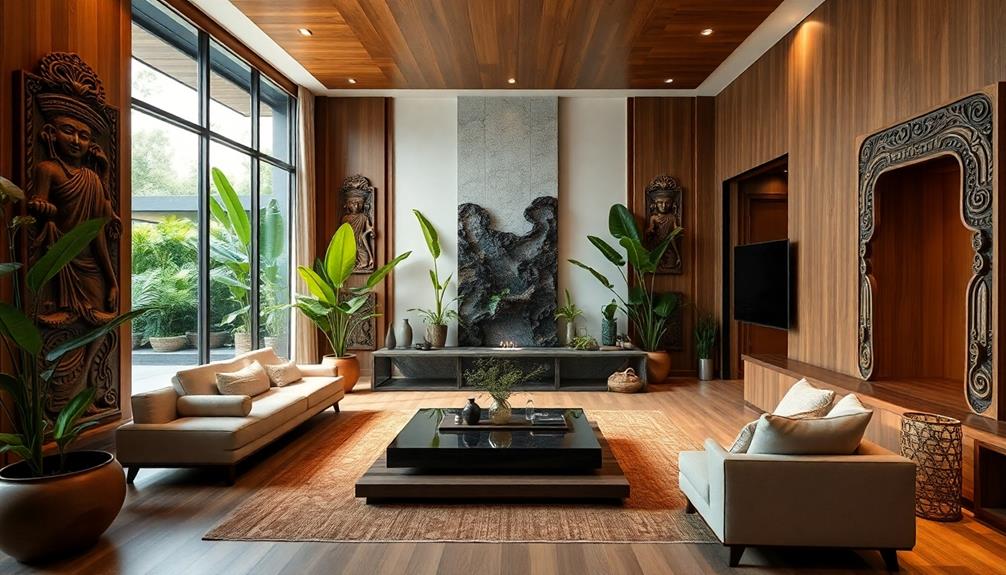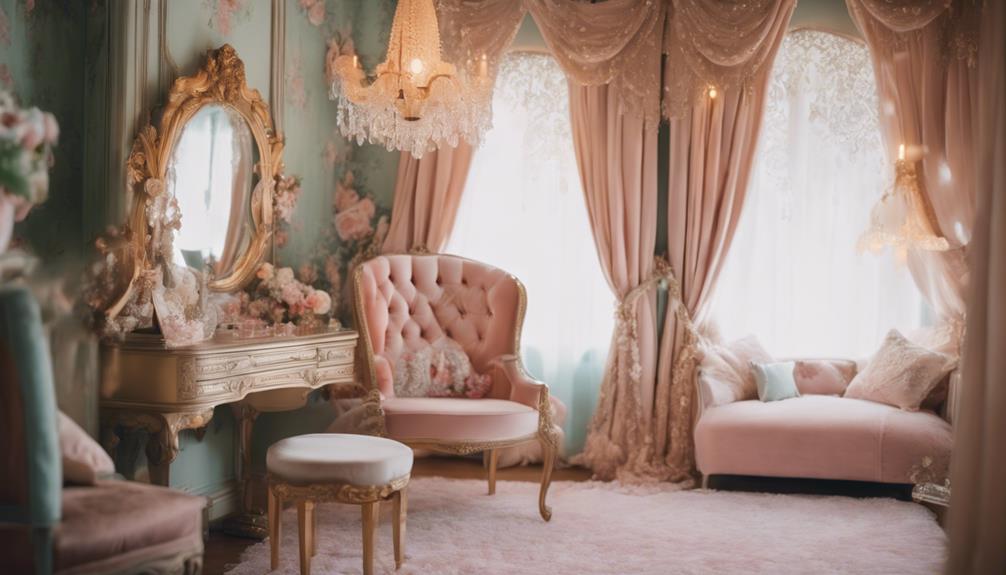To create a Balinese style in your home, start by embracing open floor plans that boost natural light and airflow. Use eco-friendly materials like bamboo and teak to enhance authenticity. Incorporate earthy color palettes mixed with vibrant accents to reflect the tropical vibe. Enhance indoor-outdoor living with lush landscaping and comfortable seating areas. Don't forget to add Balinese-inspired decor, such as handcrafted art and traditional textiles. Finally, focus on sustainable practices like natural ventilation and renewable energy solutions. This approach not only beautifies your space but also fosters a serene atmosphere, revealing even more ideas for your project ahead.
Key Takeaways
- Embrace open floor plans with large sliding doors to connect indoor spaces with lush outdoor environments, enhancing natural light and airflow.
- Utilize locally sourced, eco-friendly materials like bamboo and teak for authenticity and sustainability in your home design.
- Incorporate earthy color palettes with vibrant accents to reflect Bali's tropical flora while creating a calming atmosphere.
- Add handcrafted Balinese decor, such as traditional textiles and carved wooden elements, to infuse cultural richness into your interiors.
- Enhance outdoor living by creating lush landscaping with native plants and comfortable seating areas for relaxation and connection with nature.
Embrace Open Floor Plans
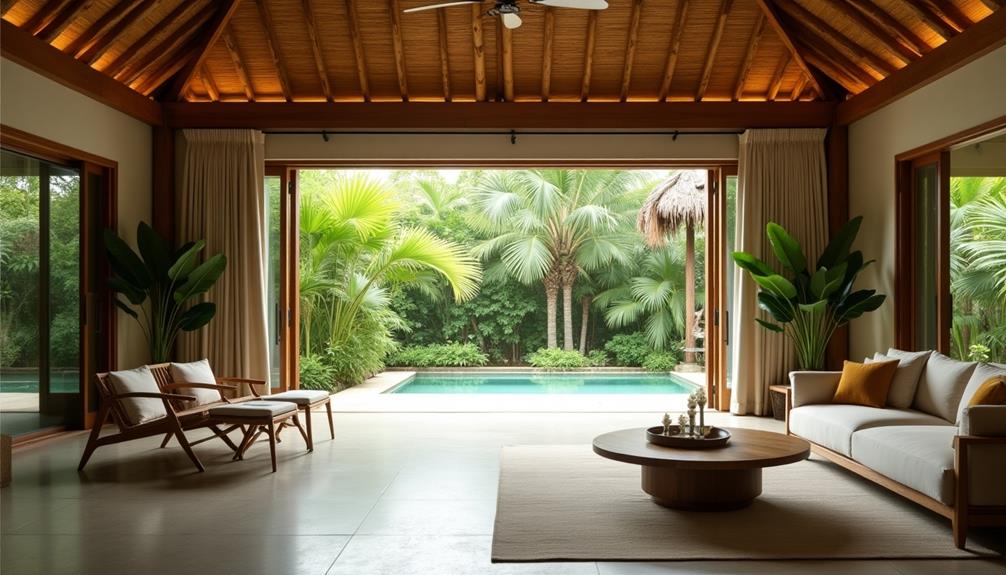
Embracing open floor plans in Balinese-style homes transforms your living space into a bright and airy sanctuary. These designs allow natural light and airflow to flood your home, creating an inviting atmosphere that blurs the line between indoor and outdoor spaces.
With large windows and sliding doors, you'll invite the lush tropical landscape right into your living area, enhancing your connection with nature. This design approach not only highlights the beauty of natural materials but also fosters a sense of tranquility that's essential in Balinese decor.
Open floor plans also promote social interactions by allowing fluid shifts between different living areas. You'll find that family gatherings and entertaining friends become effortless, fostering a sense of community and togetherness.
High ceilings in these open spaces contribute to a feeling of expansiveness, making even smaller homes feel larger and more welcoming.
Additionally, the minimalist approach often adopted in open floor plans helps you maintain a clutter-free environment. By emphasizing tranquility and harmony with nature, you'll create a serene atmosphere that encourages relaxation and peace.
Ultimately, embracing open floor plans in your Balinese-style home not only enhances aesthetics but also enriches your daily life, allowing you to fully appreciate the beauty and functionality of your space.
Utilize Natural Materials
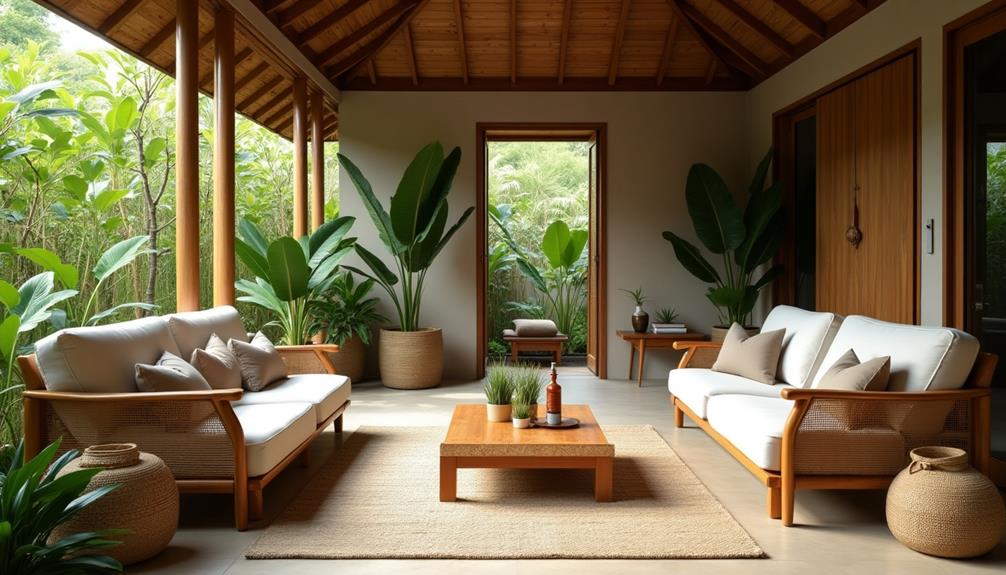
When you're designing your Balinese-style home, consider incorporating locally sourced materials like bamboo and teak for authenticity and sustainability.
Utilizing traditional Indonesian style elements, such as intricate carvings and natural stone, will enhance the richness of your decor.
You'll appreciate the rich textures of natural stone and thatched roofs, which not only enhance aesthetics but also provide durability.
Embrace Local Sourcing
Utilizing locally sourced materials like bamboo and teak wood not only enhances the durability of your home but also pays homage to traditional Balinese architecture. By choosing these sustainable materials, you contribute to both the local economy and the environment.
| Material | Benefits |
|---|---|
| Bamboo | Durable, lightweight, and eco-friendly |
| Teak Wood | Naturally resistant to weather and pests |
| Natural Stone | Aesthetic appeal and thermal regulation |
Incorporating natural stone and brick in your building design promotes thermal regulation, reducing the need for artificial cooling in your Balinese home. Opt for thatched roofs made from natural palm leaves, providing excellent insulation while embodying classic Balinese style.
Additionally, choose handmade textiles from local artisans, such as linen and cotton. This not only brings authenticity to your interior spaces but also supports local craftsmanship. Finally, use eco-friendly finishes and paints derived from natural materials to create a healthy indoor environment. By embracing local sourcing, you create a stunning, sustainable space that reflects the beauty and tradition of Balinese homes.
Highlight Textural Variety
To create a truly authentic Balinese home, mix and match a variety of natural materials that invite touch and engage the senses. Incorporate bamboo, teak, coconut wood, and stone to craft a rich tactile experience. Each material adds character and reflects the essence of authentic Balinese design.
Additionally, consider using Indonesian decorative pillows to enhance both comfort and visual appeal in your living spaces. Use handmade textiles like linen and cotton to not only enhance comfort but also add visual warmth to your space. By emphasizing the contrast between rough and smooth textures, you can create visual interest; pair polished stone surfaces with rustic wooden features for a dynamic look.
Don't forget to showcase elements like carved wooden panels or intricate sculptures that highlight local artisan craftsmanship. These pieces connect your home to the rich cultural heritage of Bali and elevate its authenticity.
Prioritize Eco-Friendly Choices
Embracing eco-friendly choices in your Balinese home starts with selecting natural materials that reflect both beauty and sustainability. By incorporating locally sourced materials like bamboo, teak, and coconut wood, you support local craftsmanship while enhancing your home's eco-friendliness. Natural finishes, such as stone and clay, create a harmonious aesthetic that blends perfectly with the surrounding landscape.
Consider implementing thatched roofs made from natural palm leaves; they provide durability against tropical storms while maintaining a traditional Balinese look. Opt for eco-friendly paint options with low VOCs to improve indoor air quality and align with sustainable design principles. Additionally, choosing natural textiles like linen and cotton for furnishings promotes comfort and reduces reliance on synthetic materials, further supporting your eco-conscious lifestyle.
| Material Type | Benefits | Emotional Connection |
|---|---|---|
| Bamboo | Strong, lightweight, sustainable | Warmth and natural beauty |
| Teak | Durable and versatile | Timeless elegance |
| Coconut Wood | Unique patterns, eco-friendly | Earthy, tropical feel |
| Natural Stone | Unique textures, long-lasting | Connection to nature |
| Linen & Cotton | Comfort and breathability | Cozy, inviting atmosphere |
Incorporate Earthy Color Palettes
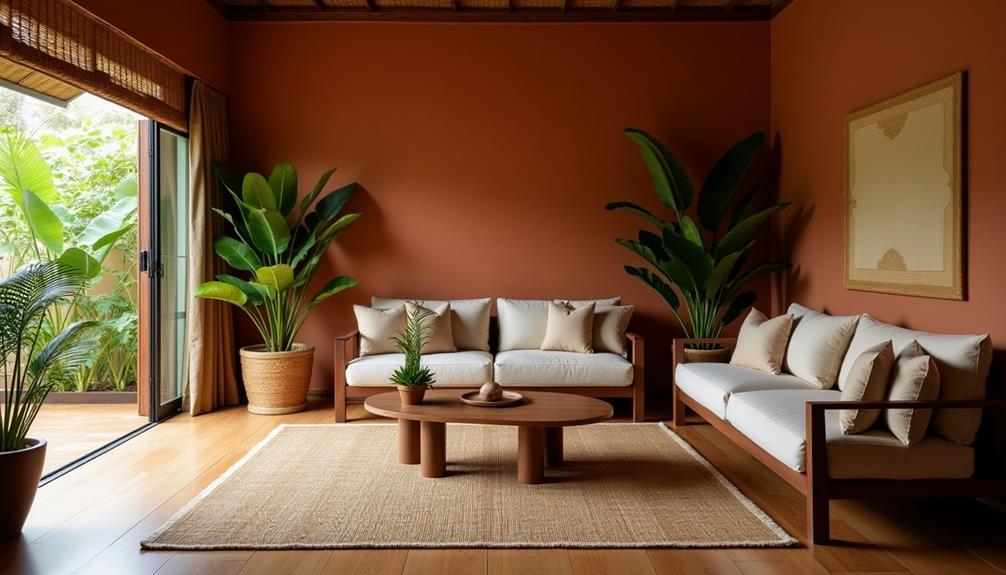
To create a serene Balinese atmosphere, embrace natural earth tones like terracotta and warm browns in your home.
Incorporating elements of modern tropical aesthetics can further enhance the connection to nature.
You can easily add bright accent colors to bring vibrancy and balance those hues with neutral shades for versatility.
This approach not only enhances your space but also connects it to the beauty of Bali's natural surroundings.
Embrace Natural Earth Tones
Incorporating earthy color palettes into your home instantly brings a calming vibe that echoes Bali's natural beauty. To embrace natural earth tones, consider using warm browns, soft beiges, and muted greens, which are often found in the design of traditional Indonesian housing, such as Rumah Adat.
These colors create a serene atmosphere, reflecting the tranquil environment of traditional Balinese landscapes. You can enhance this calming effect by incorporating blues and greens, reminiscent of the ocean and lush foliage.
This connection to nature promotes a sense of peace, perfect for any living space. Neutral shades serve as a backdrop, allowing natural materials like wood and stone to shine.
When selecting furniture and decor, opt for natural finishes that complement your earthy color scheme. This choice fosters an authentic ambiance that resonates with the traditional Balinese aesthetic.
Add Bright Accent Colors
Bright accent colors can truly transform your home by adding energy and vibrancy to the calming earthy tones you've established. Incorporating vibrant reds, yellows, and oranges reflects the rich tropical flora of Bali, infusing your space with warmth and liveliness.
These bright accent colors bring visual interest and create focal points, especially when used on decorative items like cushions, artwork, or wall hangings. Consider enhancing your decor with traditional artistry by including Indonesian decor masks that capture the essence of local culture.
To achieve a cohesive design, you can pair these bright accents with your earthy color palette, which includes shades of browns, greens, and muted blues.
The natural finishes in these earthy tones promote tranquility, while the bright colors enhance that serenity with a playful twist. This harmonious balance allows for flexibility in your decor, enabling seasonal updates that keep your home feeling fresh and inviting.
Balance With Neutral Shades
Neutral shades form the foundation of a Balinese-inspired home, creating a serene atmosphere that mirrors the island's natural beauty. Incorporating earthy tones like terracotta, sand, and muted greens enhances your space while ensuring tranquility.
This balanced palette serves as a versatile backdrop, allowing you to introduce vibrant accent colors inspired by tropical flora without overwhelming the environment. To achieve this authentic aesthetic, consider using elements from luxury tropical designs that reflect the richness of Bali's landscape.
Here are three key ways to achieve this balance:
- Choose Natural Finishes: Use wood and stone in neutral tones to enhance the authenticity of your space. These materials create a seamless connection to the outdoors.
- Layer Textures: Incorporate textiles and decor in neutral shades to add depth and interest. Consider cushions, rugs, and throws that align with the minimalist aesthetic found in many Balinese homes.
- Consult an Interior Designer: An experienced interior designer can help you choose the right earthy palettes and textures, ensuring your home embodies the calming beauty of Bali.
Enhance Indoor-Outdoor Living
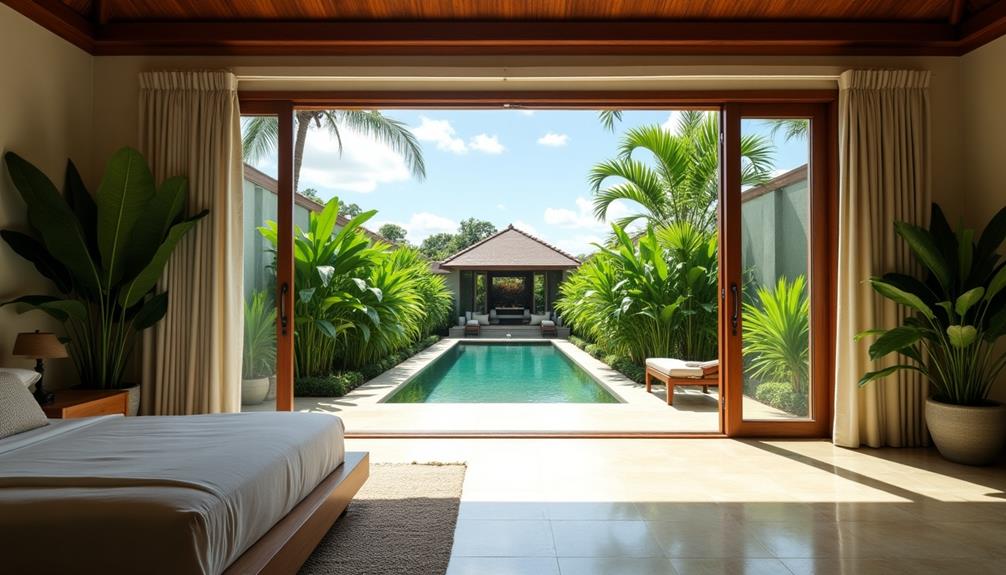
Creating a seamless connection between your indoor and outdoor spaces can transform your home into a serene retreat. Large, sliding glass doors work wonders, allowing easy access to your outdoor patios or gardens while promoting a natural flow between environments.
You'll find that having much space to move around enhances your enjoyment of both areas. To further enhance this environment, consider incorporating elements of tropical contemporary architecture that prioritize eco-friendly designs and aesthetics.
Choose natural materials like bamboo and wood for your outdoor furniture. They not only endure the tropical climate but also align beautifully with the aesthetic you're aiming for.
Consider designing open-air spaces, such as gazebos or terraces, that serve as social gathering areas. These spots allow for relaxation and enjoyment of the surrounding nature.
Integrating vibrant plant life into your indoor and outdoor spaces creates a cohesive tropical atmosphere. This connection enriches the sense of serenity throughout your home.
Additionally, adding water features like ponds or fountains can provide a soothing auditory backdrop, elevating your indoor-outdoor living experience.
Integrate Lush Landscaping
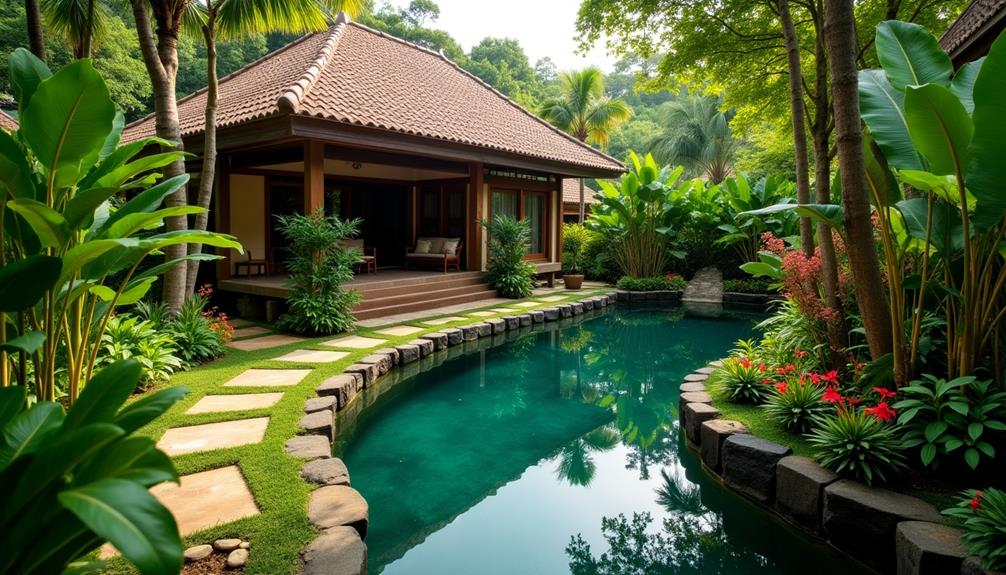
Transform your outdoor space by integrating lush landscaping that reflects the natural beauty of Bali. By incorporating native plants and trees, you'll promote biodiversity and guarantee your garden thrives in its local environment.
Contemplate enhancing your decor with vibrant floral displays that reflect Bali's rich biodiversity. Here are three essential elements to ponder:
- Water Features: Include ponds or fountains to enhance tranquility. In Balinese culture, water symbolizes fertility and abundance, creating a peaceful ambiance in your garden.
- Stone Pathways: Create natural stone pathways to facilitate flow through your garden. This encourages exploration and appreciation of the lush surroundings, making every stroll a delightful experience.
- Outdoor Seating Areas: Design comfortable seating areas among the greenery for relaxation and social gatherings. Incorporate shade structures like pergolas or umbrellas to guarantee you can enjoy these spaces throughout the day, even in the tropical climate.
Add Balinese-Inspired Decor
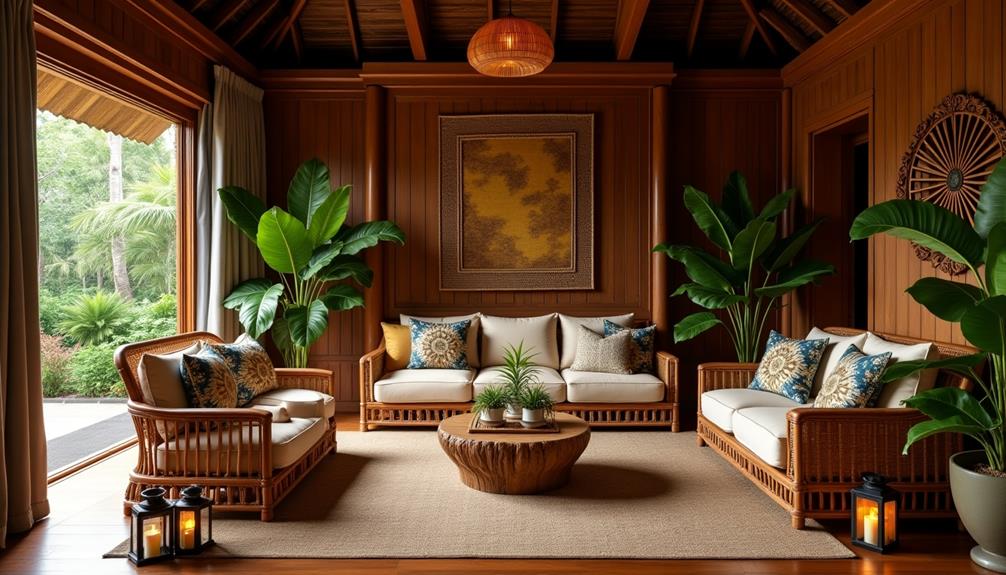
After enhancing your outdoor space with lush landscaping, it's time to bring the essence of Bali indoors by adding Balinese-inspired decor.
Start by incorporating handcrafted Balinese art pieces, like intricate wood carvings or stone sculptures, to infuse cultural richness and visual interest into your home. Consider adding a unique artistic expression through Indonesian decor masks, which can easily transform any room into a cozy Balinese villa atmosphere.
Next, utilize traditional textiles such as batik or ikat for your cushions and throws. These vibrant colors and patterns reflect the tropical environment and add warmth to your living space.
When it comes to furniture, choose natural materials like bamboo and teak. This not only creates an authentic Balinese aesthetic but also connects your interior with nature.
Don't overlook architectural elements; incorporate carved wooden panels or decorative screens to enhance your space's style while providing privacy.
Finally, integrate indoor plants and natural greenery to mimic Bali's lush landscapes, promoting a serene and invigorating atmosphere.
Focus on Sustainable Practices
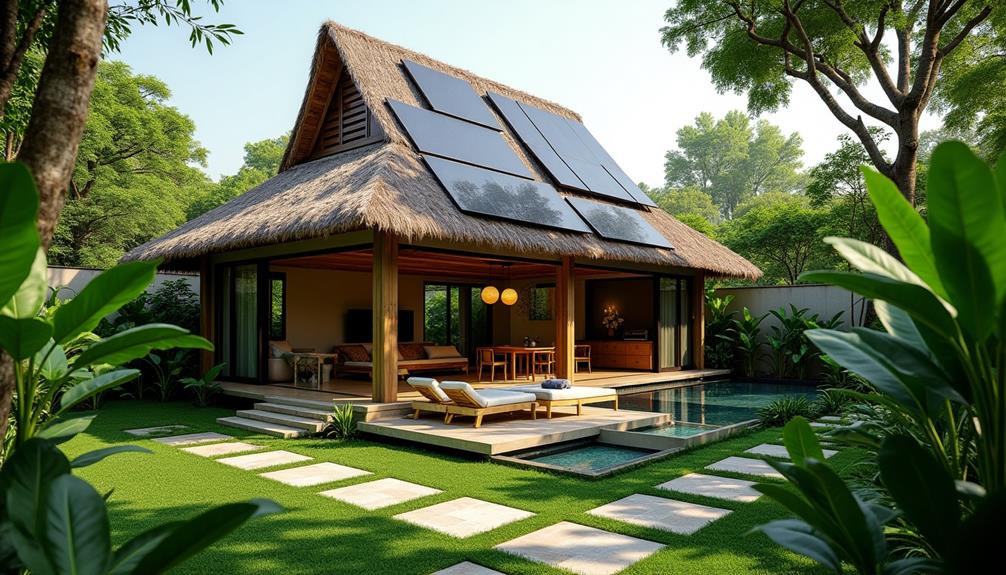
How can you embrace the beauty of Balinese style while prioritizing sustainability? By focusing on sustainable practices, you can create an eco-friendly home that reflects the serene essence of Bali. Here are three effective ways to achieve this:
- Locally Sourced Materials: Use bamboo, teak, and stone to minimize your carbon footprint and support local artisans. These materials not only enhance the aesthetic but also promote sustainable practices.
- Renewable Energy Solutions: Install solar panels to harness renewable energy, greatly cutting down on electricity costs and reducing reliance on fossil fuels. This not only helps the planet but also saves you money in the long run.
- Water Conservation Systems: Implement rainwater harvesting systems to collect and store rainwater for irrigation. This promotes sustainability in landscaping while conserving valuable water resources.
Additionally, consider natural ventilation techniques, like strategically placed windows, to improve airflow and reduce the need for air conditioning.
Emphasizing eco-friendly finishes, such as non-toxic paints and natural textiles, can also contribute to a healthier indoor environment.
Frequently Asked Questions
How Can I Make My House Feel Like Bali?
To make your house feel like Bali, embrace open spaces with large windows, use natural materials, choose earthy colors with vibrant accents, and incorporate water features and lush plants for a serene, tropical atmosphere.
What Is the Balinese Architecture of Houses?
Balinese houses often feature three courtyards, fostering harmony and connection. You'll notice open floor plans, natural materials, and intricate carvings, creating a serene atmosphere that invites nature indoors while ensuring privacy in secluded areas.
What Makes a Balinese?
A Balinese home's essence lies in its harmony with nature. You'll appreciate open spaces, natural materials, and intricate artistry. Incorporating water features and communal areas fosters tranquility, creating an inviting atmosphere that celebrates culture and connection.
Conclusion
By embracing these seven tips, you can transform your home into a serene Balinese oasis. Imagine sipping your morning coffee surrounded by lush greenery, as the gentle breeze whispers through open spaces. But wait—what if you could take it a step further? What hidden treasures could you uncover in your own backyard? Dive deeper into Balinese style, and you might just discover the tranquility and beauty that awaits you, right at home. Don't miss out!

